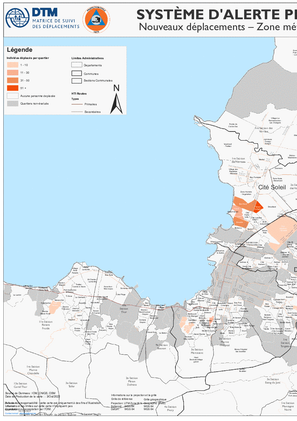-
Countries
-
Data and Analysis
-
Special Focus
-
Crisis Responses
Oct 07 2022
Print
Countries in this response
- Active DTM operation
- Past DTM operation
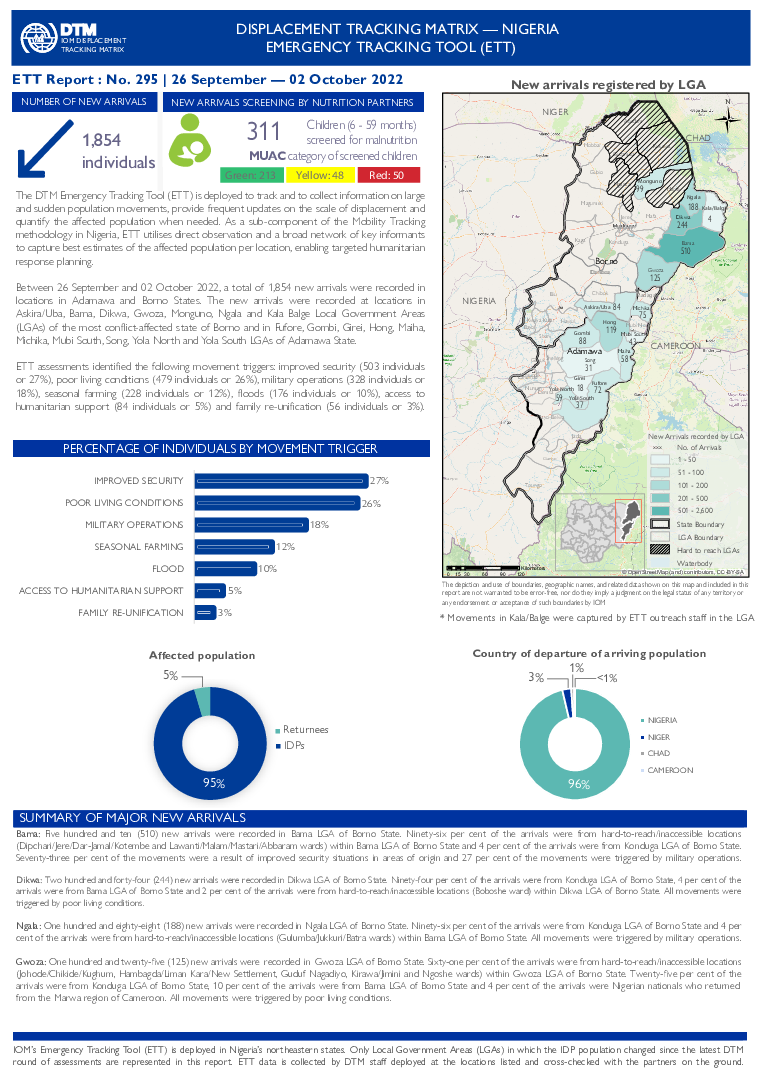
Contact
DTM Nigeria, AllUsersInDTMNigeria@iom.int
Language
English
Location
Nigeria
Period Covered
Sep 26 2022
Oct 02 2022
Activity
- Mobility Tracking
- Event Tracking
The DTM Emergency Tracking Tool (ETT) is deployed to track and to collect information on large and sudden population movements, provide frequent updates on the scale of displacement and quantify the affected population when needed. As a sub-component of the Mobility Tracking methodology in Nigeria, ETT utilises direct observation and a broad network of key informants to capture best estimates of the affected population per location, enabling targeted humanitarian response planning.
Between 26 September and 02 October 2022, a total of 1,854 new arrivals were recorded in locations in Adamawa and Borno States. The new arrivals were recorded at locations in Askira/Uba, Bama, Dikwa, Gwoza, Monguno, Ngala and Kala Balge Local Government Areas (LGAs) of the most conflict-affected state of Borno and in Fufore, Gombi, Girei, Hong, Maiha, Michika, Mubi South, Song, Yola North and Yola South LGAs of Adamawa State.

Contact
DTM Nigeria, AllUsersInDTMNigeria@iom.int
Language
English
Location
Nigeria
Period Covered
Sep 01 2022
Sep 30 2022
Activity
- Mobility Tracking
- Baseline Assessment
- Points of Entry (PoE)
During the COVID-19 pandemic, IOM's Displacement Tracking Matrix (DTM), in collaboration with the World Health Organization (WHO), monitors cross-border movements to and from Nigeria's Borno State in north-east Nigeria. Assessments are conducted at Points of Entry located along the border with Cameroon.
A range of data was collected during the assessments to better inform on travellers’ nationalities, sex, reasons for moving, mode of transportation and timeline of movement as shown in figures 2 to 5 on the dashboard.
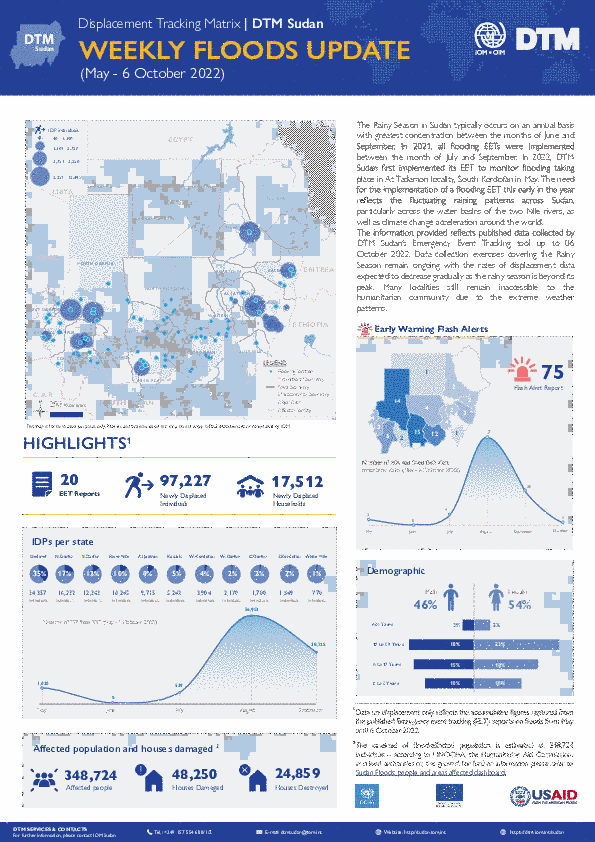
Contact
dtmsudan@iom.int
Language
English
Location
Sudan
Period Covered
May 01 2022
Oct 06 2022
Activity
- Event Tracking
The Rainy Season in Sudan typically occurs on an annual basis with greatest concentration between the months of June and September. In 2021, all flooding EETs were implemented between the month of July and September. In 2022, DTM Sudan first implemented its EET to monitor flooding taking place in At Tadamon locality, South Kordofan in May. The need for the implementation of a flooding EET this early in the year reflects the fluctuating raining patterns across Sudan, particularly across the water basins of the two Nile rivers.
The information provided reflects published data collected by DTM Sudan’s Emergency Event Tracking tool up to 29 September 2022. Data collection exercises covering the Rainy Season remain ongoing with the rates of displacement data expected to decrease gradually as the rainy season is beyond its peak. Many localities still remain inaccessible to the humanitarian community due to the extreme weather patterns.
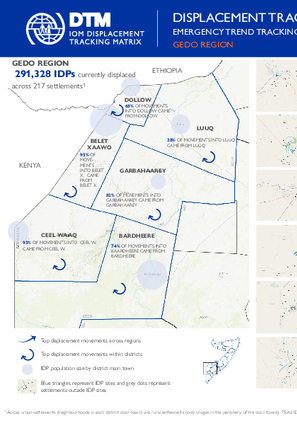
Contact
DTM Somalia, IOMSomaliaDTM@iom.int
Language
English
Location
Somalia
Period Covered
Sep 17 2022
Sep 21 2022
Activity
- Mobility Tracking
- Event Tracking
Since November 2021, 291,328 individuals have been displaced by drought in Gedo region. Since round 28, an estimated 7,076 IDPs arrived at the assessed settlements.

Contact
DTM Somalia, IOMSomaliaDTM@iom.int
Language
English
Location
Somalia
Period Covered
Sep 10 2022
Sep 14 2022
Activity
- Mobility Tracking
- Event Tracking
Since November 2021, 285,436 individuals have been displaced by drought in Gedo region. Since round 27, an estimated 8,590 IDPs arrived at the assessed settlements.

Contact
DTM Guinée, oimguineedtm@iom.int
Language
French
Location
Guinea
Period Covered
Jul 27 2022
Aug 04 2022
Activity
- Survey
La vulnérabilité des migrant-e-s augmente le long des routes migratoires. En effet, ayant quitté leurs territoires d’origine et dépourvu de la protection de leurs communautés, les migrant-e-s sont exposé-e-s aux réseaux criminels qui mettent en place des mécanismes d'exploitation afin de tirer illégalement profit des plus vulnérables d’entre eux. De nombreux facteurs aggravent la vulnérabilité des migrant-e-s en général et celle de certaines catégories de migrant-e-s en particulier, notamment la féminisation progressive des flux migratoires, l'augmentation du nombre d'enfants migrants non accompagnés et séparés, et le renforcement des réseaux de traite des personnes bien établies le long des routes migratoires, visant particulièrement les enfants.
La préfecture de Mamou est l’une des préfectures avec le taux de départ le plus élevé pour peu de données fiables disponibles. Cette étude contribuera à pallier ce déficit de données et permettra in fine de mettre à disposition une analyse de données fiables pour faciliter la compréhension des tendances et dynamiques migratoires, les prises de décisions gouvernementales et institutionnelles en lien avec la migration, et de ce fait, améliorer les réponses à apporter pour limiter les conséquences négatives de la migration irrégulière. Au vu de l’évolution importante de ce phénomène migratoire en Guinée, il apparaît déterminant de collecter, traiter et analyser les données sur cette question.
L’apparition de la pandémie de coronavirus (COVID-19) a en outre eu un impact sur les activités et opportunités socio-économiques des migrant-e-s mises en place pour les migrant-e-s de retour, y compris ceux/celles déjà réintégré-e-s à travers les activités génératrices de revenu (AGR) des migrant-e-s.
Afin de mieux comprendre les facteurs qui sous-tendent les nouvelles dynamiques migratoires irrégulières observées dans la préfecture de Mamou, identifier les impacts des épidémies sur les conditions socio-économiques des migrant-e-s et explorer des solutions pour assurer la protection et la sûreté des migrant-e-s qui quittent la préfecture de Mamou ; une mission de collecte des données conduite conjointement par l’Organisation Internationale pour les Migrations (OIM) et l’Institut National de la Statistique (INS) guinéen a mené une étude dans les localités de la commune urbaine de Mamou, (Tolo et Soyah) du 27 juillet au 4 août 2022 à travers les outils de la DTM.
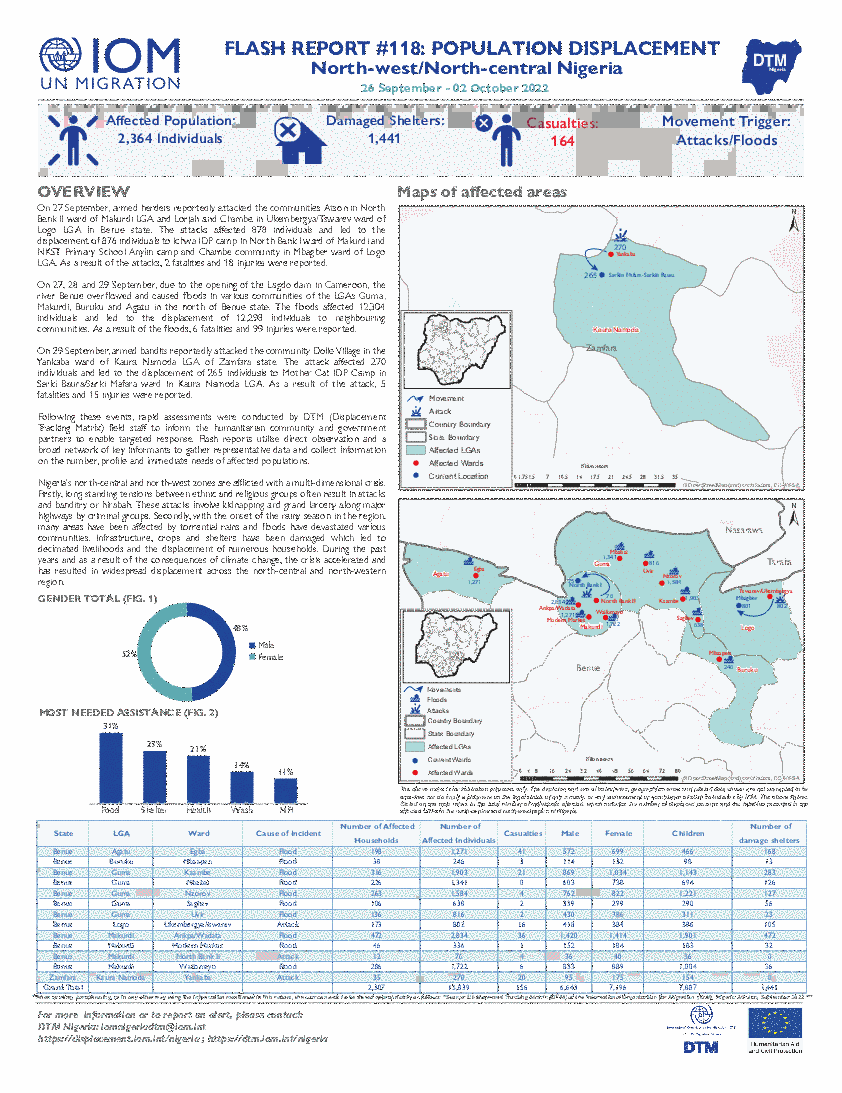
Contact
DTM Nigeria, AllUsersInDTMNigeria@iom.int
Language
English
Location
Nigeria
Period Covered
Sep 26 2022
Oct 02 2022
Activity
- Mobility Tracking
- Event Tracking
On 27 September, armed herders reportedly attacked the communities Atson in North Bank II ward of Makurdi LGA and Lorjah and Chambe in Ukembergya/Tswarev ward of Logo LGA in Benue state. The attacks affected 878 individuals and led to the displacement of 876 individuals to Ichwa IDP camp in North Bank I ward of Makurdi and NKST Primary School Anyiin camp and Chambe community in Mbagber ward of Logo LGA. As a result of the attacks, 2 fatalities and 18 injuries were reported.
On 27, 28 and 29 September, due to the opening of the Lagdo dam in Cameroon, the river Benue overflowed and caused floods in various communities of the LGAs Guma, Makurdi, Buruku and Agatu in the north of Benue state. The floods affected 12,304 individuals and led to the displacement of 12,298 individuals to neighbouring communities. As a result of the floods, 6 fatalities and 99 injuries were reported.
On 29 September, armed bandits reportedly attacked the community Dolle Village in the Yankaba ward of Kaura Namoda LGA of Zamfara state. The attack affected 270 individuals and led to the displacement of 265 individuals to Mother Cat IDP Camp in Sarki Baura/Sarki Mafara ward in Kaura Namoda LGA. As a result of the attack, 5 fatalities and 15 injuries were reported.
Carte des Nouvelles arrivées des PDI dans la zone métropolitaine de Port-au-Prince, du 10 - 16 septembre 2022.
Carte des nouveaux déplacements – Zone métropolitaine de Port-au-Prince – 10 - 16 septembre 2022.

